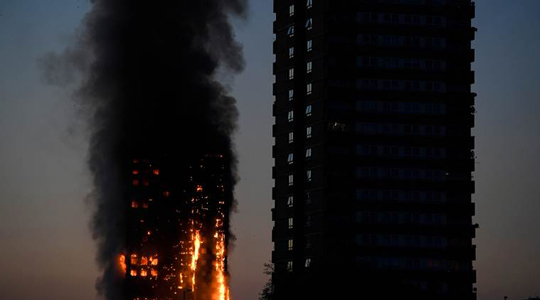London, Jun 14: Fire swept through a high-rise apartment building in west London early Wednesday, killing an six people and sending more than 50 people to area hospitals.

Flames shot from windows all the way up the 24-story Grenfell Tower in North Kensington as more than 200 firefighters battled the blaze. A plume of smoke stretched for miles (kilometers) over the capital.
“This is an unprecedented incident,” Fire Commissioner Dany Cotton told reporters on the scene. “In my 29 years of being a firefighter I have never, ever seen anything of this scale.”
Cotton said a number of people died in the fire, but she couldn’t confirm how many because of the size and complexity of the building. Witnesses said that they saw people jumping from the upper floors.
The London Fire Brigade received the first reports of the fire at 12:54 a.m. and the first engines arrived within six minutes, she said.
The cause of the fire was not immediately known. Residents said the blaze appeared to start in an apartment on a lower floor and spread upward quickly.
People at the scene spoke of being unable to reach friends and family inside. Others said they could see people inside using flashlights and mobile phones to try to signal for help from higher floors.

Nassima Boutrig, who lives opposite the building, said she was awakened by sirens and smoke so thick that it filled her home as well.
“We saw the people screaming,” she said. “A lot of people said ‘help, help, help.’ The fire brigade could only help downstairs. It was fire up, up, up. They couldn’t stop the fire.”
Boutrig said her friend’s brother, wife and children lived in the building and that her friend was waiting to find out if they were OK.
Other survivors spoke of confusion and conflicting advice given to residents, many of whom had been advised in advance not to leave their apartments in the event of a fire.
“There were no fire alarms,” said Edward Daffarn 55, who was warned by a neighbor to flee. “There was heavy smoke in the hallway. I could not find the stairs.”
Others searched for information at makeshift evacuation centers set up at churches and recreation centers.
At St. Clement’s Church, where evacuees gathered, Hadra Hassad was trying to find one of her closest friends, who lived on the 21st floor. Hassad says she believes one of her friend’s daughters is in a hospital, but didn’t know which one.
Ambulances and fire trucks filled the streets around the building, which is located in a diverse, working class area of London. People who live nearby were evacuated, some carrying pets in their arms as they left. Volunteers handed out bottled water.
Helicopters hovered overhead and smoke hung over the scene. Exhausted firefighters sprawled on the pavement just inside the police cordon, drinking water from plastic bottles.
“Crews wearing breathing apparatus and extended duration breathing apparatus have been working in extremely challenging and difficult conditions to rescue people and bring this major fire under control,” Cotton said.
George Clarke told Radio 5 Live that he was covered in ash even though he was 100 meters (yards) from the scene.
He said he saw people waving flashlights from the top levels of the building and saw rescuers “doing an incredible job” trying to get people out.
Tim Downie, who lives not far away, told Britain’s Press Association that he feared the building could collapse. He said he heard sirens, helicopters and shouting and then saw the building engulfed in flames.
“It’s the most terrifying thing I’ve ever seen. I just hope they have got everyone out,” he said. “People have been bringing water, clothes, anything they’ve got to help, out to the cordon.”
Grenfell Tower was built in 1974 and contains 120 homes, according to the Royal Borough of Kensington and Chelsea.
The building was recently upgraded at a cost of 8.6 million pounds ($11 million), with work finishing in May 2016.
The Grenfell Action Group, a community organization formed to oppose a nearby redevelopment project, has been warning about the risk of fire at Grenfell Tower since 2013. The group has raised concerns about testing and maintenance of firefighting equipment and blocked emergency access to the site.
“All our warnings fell on deaf ears and we predicted that a catastrophe like this was inevitable and just a matter of time,” the group said in a blog post written after the fire broke out.





Comments
Add new comment